“My dad taught me tonight is about respecting the dead. All the Traditions – putting out Jack O’ Lanterns, putting on costumes,
Putting out treats- were to protect us. Nowadays, no one really cares.”
–Principal Steven Wilkins (Dylan Baker).
Michael Dougherty’s TRICK ‘R TREAT could be the best “Halloween” film of all time. Maybe that’s a heady pronouncement, but it is certainly the best horror anthology flick ever made. Now, given the spotty record of that black-sheep of the horror flick cannon, that might seem like a damning statement of faint praise. There is perhaps, no harder sub-genre to pull off in the land of filmic fear than the horror movie omnibus: the crafter of such a collection has to fight the hazards of the brevity and narrative compression for each patchwork piece; avoid the pit-falls of inconsistencies of tale, tone, pacing, performance; and the effectiveness of the Framing Device, a formula that often unravels like the straw on a witch’s broom. It’s a failing-ground for the minimally talented non-auteur: the mediocre filmmaker who can’t sustain a single, involving narrative can always turn to the Horror Movie Anthology format for a quick buck, right?*
So, when I saw the DVD cover for Michael Dougherty’s Trick ‘r Treat at DVD Planet, I squinted at it as fiercely as Clint Eastwood’s Man with No Name. I knew that Dougherty had solid credits behind him (he co-wrote X-Men and Superman Returns), but I was dubious, given the genre’s modern-day track record. Yet, I decided to give it a try. After all, the anthology film was one of the first of frights I cut my teeth on as a young horror buff trooping to the Compton’s Allen Theater in the 1960s and ’70s with my brother Mark. I loved the British Amicus classics such as Tales from the Crypt, The House That Dripped Blood, and Asylum; it was only later permutations of the genre that instilled doubts as I plunked down my hard-earned cash for this new film.
There are moments where Dougherty’s cheeky-creepy post-modern take on those omnibus films of yester-year (and not so long ago) seems almost a little too sleek, a little too smarty-pants insouciant for its own good, maybe too-well crafted, but it’s impossible to deny the savor and commitment of this blood-dipped candy-apple of a chiller, which returns the former pagan holiday back to the delights of old-school frights. Anyone who remembers what it was like to be young, trundling out into the dark night, mask on head, treat bag in hand, steeling the nerve to go up to a stranger’s Jack O’ Lantern-lit porch to ring the doorbell will make Trick ‘r Treat a featured favorite for future October 31st viewings.
Guided by the spirit of fairy-tales and such genre stand-bys as EC and DC Comics (“House of Mystery” and “House of Secrets” come to mind here just as much as “Tales From The Crypt” and “Vault of Horror”), Dougherty’s smartly crafted filmic paen to All Hollow’s Eve traditions (while adding a knowing nudge here and there at the holiday’s entrenched commercialism and adult-party posteuring) is one inspired little “boo!” of autumn night angst. Perhaps Dougherty succeeded all too well in bringing the fear down to an adolescent’s mask-eye view: Warners, maybe a tad unsettled by all the kid grue and jeopardy, opted to pass on a theatrical release, and chose the direct-to-vid route. It’s one of the two injustices that afflict a film which should have received theatrical distribution to the respect and acclaim it deserves. (The other injustice is the lack of Special Features on the DVD, but more about that later.)
One of the film’s irresistibly clever ideas is to ditch a straightforward narrative, interweaving the four tales of fear (ala Pulp Fiction) during a single Halloween night in the Ohio burg of Warren Valley, which takes the holiday very seriously. After a terrific prologue (which will wind up as a chunk of the epilogue) in which a premature Jack O’ Lantern snuffer is turned into a grisly “Trick” by a tradition-defending beastie, the movie splits its narrative into a series of interlaced plot-lines. These include virginal Anna Pacquin (garbed-up as Little Red Riding Hood in one of the movie’s ironic touches), searching for Mr. Right before heading out to an unspeakable woodland bacchanal where she and her hottie gal-pals are going to party with their “dates”; a high school principal (Dylan Baker) who is also a season-minded serial-killer; a quartet of cruel youngsters who visit the site of a grisly local urban-legend to play an gruesome “Trick” on a mentally challenged girl (Samm Todd); and a grumpy old Halloween hum-bugger (Brian Cox, looking very much like John Carpenter) who seems to have a real chip on his shoulder towards the meaning of the season. And, popping up every now and then there’s “Sam” (short for “samhain”) a monstrous little sprite in burlap sack-mask and orange pajamas, who takes serious (and murderous) umbrage to those who deny respect to the traditions of the All Hollows Eve holiday.
Though it’s not a stretch of the imagination to see some of the “tricks” and “treats” coming (it doesn’t mitigate the fear and fun factor), you cannot help feeling a voluptuous glee in the manner in which Dougherty plays with filmic time and confidently weaves the various plot-lines together, breaking up the action with the occasional bit of comic-book graphic transition and having characters reappear for random bits in other stories. This yields some fine pay-offs: there’s an early scene wherein Cox, as Dylan’s curmudgeonly neighbor, is hammering at his window trying to get the Dylan’s attention (he’s distracted by matters of his own, to use an understatement) only to be whisked away from the glass by something unseen, produces juicy dividends when the scene plays out later on. Ditto for Dylan’s unexpected reappearance later in the episode, when his storyline solidly intersects one of the other narrative pieces (it would be irresponsible to give away any more details but it provides satisfying closure).
This is all dished up with equal parts camp and terror, with minimal computer fuss (it’s hard not to smile at the cheesey fun of a simple fx fixtue like a murderous scuttling severed hand). The movie captures the holiday’s autumnal sense of death and dread: maybe the neighbor next door will give you a big handful of candy, or maybe he’ll plant you in a moon-lit grave in his front yard; maybe the mean old man next door has a good reason for scaring kids off his stoop when they beg for candy, or keeping a loaded shot-gun on the wall; maybe putting a scare into the “Strange Kid” with the pumpkin fetish isn’t the best idea.
The movie’s best segment, which follows the EC-Comic formula to a T, and would definitely earn a Crypt-Keeper Cackle of Approval is the “Halloween School Bus Massacre”, with Gaines-style twisted twist and all, about a group of tweens who suffer the consequences of mocking the dead on All Hollows Eve. The way the tale unfolds (“It happened 30 years ago,” the mean but angel-winged gang-leader begins) – going from growing creep-out to outright terror – is near perfect. The flashback to a school-bus full of disturbed children (which to me resemmbled an hommage to the fitfully effective and fairly cruel ‘70s low-budgeter Devil Times Five aka Peopletoys), is one of the most unsettling scenes in a recent horror movie – and it’s totally done through masks and costumes! Glen MacPherson lays an October garnish of diffuse gold over the cinematography, which perfectly limns the unease and nostalgia of a great urban-ghost story. Given contemporary cinema’s penchant for preternaturally glib children, or swooning adolescent vampires, the fact that this story so rightly nails Halloween terrors from a kid’s point-of-view, is one of the most refreshing elements of the movie, and this segment neatly encapsulates one of the true pleasures of the film.
Sadly, Dougherty’s decision to put the kiddies front and center is probably what led Warners to sentence the movie to its DTV fate: the studio heads who viewed the finished cut must have gone apoplectic at the sequence in which a pumpkin-smashing tubby kid gets his grisly comeuppance when he’s fed some “Bad Candy” by Dylan Baker’s season-sensitive psycho principal. This is certainly the movie’s “gross-out” set-piece and the overall nastiest bit (it certainly plays into one of the worst All Hollow’s Eve fears). What is hackle-raising about the scene is the casting of the dotty school administrator: in a perverse and funny-queasy stroke, Dougherty gave the role to Baker, who was the unforgettably disturbing pedophile psychiatrist from Todd Solondz’s Happiness, and it is squirm-inducing to see him cozying up to the hapless victim on the porch step, waving a carving knife and good-naturedly teasing the doomed victim (“Oh, don’t worry, it’s for the Jack O’ Lantern, not you”): mental flashbacks to that earlier film left me in little doubt about just what Principal Wilkins was going to do. Certainly, the violence in “The Halloween School Bus Massacre” is more of the suggestive sort, and (for the most part) takes place off-screen, but it certainly had to have contributed to the general release jitters.Then again, given the playing time of many films these days, it could be a mixed blessing: Trick ‘r Treat will definitely wind up as any horror buff’s choice of chills come the dark, dead-leaf-bedecked long falls nights; the film seems destined to profit from a reputation as one of those Overlooked Gems.
On a technical level, Trick ‘r Treat is amazingly assured for a first-time director, and the film’s color palette nicely compliments those baleful comic-book thrills from the past; Macpherson’s photography, Robert Ivison’s editing, and Douglas Pipes’ music (the soundtrack includes a blackly comedic rendition of the Eurythmics “Sweet Dreams Are Made of These”) compliment the film’s mood. Trish Keating deserves praise for the costume design (the masks of The Disturbed Kids of “The Halloween School Bus Massacre” episode are singularly chilling, while Anna Paquin’s chick support squad’s duds are a funny, ironic hoot.
The performers seem to all be clued in to the fun. Pacquin is quite good as the virginal miss who is well-prepared for any and all Big Bad Wolves, and the youngsters (especially Samm Todd) all deliver naturalistic, uninflected performances, giving their horrific scenes a greater sense of concern and investment. However, Baker and Cox are the stand-outs. Baker as the button-down, respectable town slayer (complete with a creepy son who loves “doing the eyes” on their “Jack O’ Lanterns”) does a terrific job; Cox steals the show as the movie’s “Scrooge” figure who has a good rationale (revealed in a fine twist) for his dislike of the season. Wearing a white frizzy John Carpenter mane of hair (he even gets to utter a choice line from Carpenter’s remake of The Thing), Cox gets a terrific Evil Dead-style battle with Sam that has a nice retro-effects feel and unexpected ending. If the film has a major weakness, maybe it’s the fact that the omnibus format has its own built-in Achilles heel: without a central conflict or identification figure, the empathy factor is a little thin at times (a good chunk of the cast are monsters, human or otherwise, thiough it’s hard not to root for Cox facing his own Trilogy of Terror-type beat-down in the latter part of the flick).
Sam himself is an endearing little boggart and one of the better monsters of the past few years. He’s actually a fairly complicated demon: pint-sized, in orange pajamas and burlap-mask, he’s seems rather vulnerable – until someone “disrespects” Halloween tradition, wherupon he launches into action (his main weapon is fairly cool and inventive) with results that are fairly dire. His main screen time (he’s kind of the Ghosts of Halloween Past, Present, Future against Cox’s Halloween hating codger) is in the last third of the film, though he flits through the others inflicting damage, major and minor. That said, he’s no anonymous otherworldly avenger-slasher : there are definite Rules of Engagement on Sam’s mind, as well as propitiation. One of the movie’s smart points is that he doesn’t have a back-story, thus, dissipating his mystery and persona.
Aside from the injustice of not getting a theatrical release, the paucity of DVD Special Features is definitely a crying shame. The DVD offers both a Wide-Screen and Full-Screen version, and along with a set of language and subtitle selections in English, French, Spanish. The only real treat is “Seasons Greetings,” the director’s 1996 hand-animated short, which gives us our first glimpse of the burlap-masked Sam. The commentary by Dougherty on the short is actually more entertaining than the little film, which is a nice enough low-budget (albeit predictable) thrill, but it’s really a launching point for the future monster. Clearly, this was a labor of love for Dougherty and his small crew, laying down the creation of Sam (in Dougherty’s words,“9 months of blood, sweat and tears”) in hand-printed, hand-drawn, hand-colored frames, achieved by the director-writer with different-colored magic-markers. The short enjoyed success, playing a number of festivals as well as being featured on MTV’s Cartoon Sushi, and was scored by Evan Chen, with backgrounds painted by Dan KaNemoto, and “a lot of friends and students.”
One of the brightest revelations during the commentary by the creator, is how Dougherty came up with the “blood” on Sam’s face, following his triumph over his attacker: Dougherty had cut his hand while working on the ‘toon, and having an instant epiphany “flicked my hand and splattered blood over the art-work.” As nice as it is to have Dougherty provide narrative on this humble, chilly vignette, you are left craving more, like a trick-or-treater coming home with an empty bag: the Special Features begs for Dougherty’s commentary on the feature film, his take on the performances and effects, and, most of all, the travails that cheated Trick ‘r Treat from a full-blown film-release. Both the DVD, and horror movie buffs in general, cry out for it.
FOOTNOTE:
- In compelling contrast, that Canadian indie fave, The Signal offered the terrific twist of one scary-brainy narrative helmed by three different directors.






